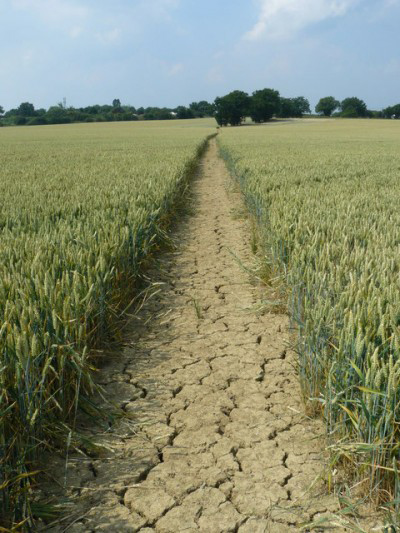Discovery Provides Insights on How Plants Respond to Elevated CO2 Levels
July 7, 2014
By Kim McDonald

The discovery could provide agricultural scientists with new tools to engineer crops that can deal with droughts and high temperatures.
Peter Trimming
Biologists at UC San Diego have solved a long-standing mystery concerning the way plants reduce the numbers of their breathing pores in response to rising carbon dioxide levels in the atmosphere.
In a paper published in this week’s early online edition of Nature, they report the discovery of a new genetic pathway in plants, made up of four genes from three different gene families that control the density of breathing pores–or “stomata”–in plant leaves in response to elevated CO2 levels.
Their discovery should help biologists better understand how the steadily increasing levels of CO2 in our atmosphere (which last spring, for the first time in recorded history, remained above 400 parts per million) are affecting the ability of plants and economically important crops to deal with heat stress and drought. It could also provide agricultural scientists with new tools to engineer plants and crops that can deal with droughts and high temperatures like those now affecting the Southwestern United States.
“For each carbon dioxide molecule that is incorporated into plants through photosynthesis, plants lose about 200 hundred molecules of water through their stomata,” explains Julian Schroeder, a professor of biology who headed the research effort. “Because elevated CO2 reduces the density of stomatal pores in leaves, this is, at first sight beneficial for plants as they would lose less water. However, the reduction in the numbers of stomatal pores decreases the ability of plants to cool their leaves during a heat wave via water evaporation. Less evaporation adds to heat stress in plants, which ultimately affects crop yield.”
Schroeder is also co-director of a new research entity at UC San Diego called “Food and Fuel for the 21st Century,” which is designed to apply basic research on plants to sustainable food and biofuel production.
“Our research is aimed at understanding the fundamental mechanisms and genes by which CO2 represses stomatal pore development,” says Schroeder. Working in a tiny mustard plant called Arabidopsis, which is used as a genetic model and shares many of the same genes as other plants and crops, he and his team of biologists discovered that the proteins encoded by the four genes they discovered repress the development of stomata at elevated CO2 levels.
Using a combination of systems biology and bioinformatic techniques, the scientists cleverly isolated proteins, which, when mutated, abolished the plant’s ability to respond to CO2 stress. Cawas Engineer, a postdoctoral scientist in Schroeder’s lab and the first author of the study, found that when plants sense atmospheric CO2 levels rising, they increase their expression of a key peptide hormone called Epidermal Patterning Factor-2, EPF2.
“The EPF2 peptide acts like a morphogen which alters stem cell character in the epidermis of growing leaves and blocks the formation of stomata at elevated CO2,” explains Engineer.
Because other proteins known as proteases are needed to activate the EPF2 peptide, the scientists also used a “proteomics” approach to identify a new protein that they called CRSP (CO2 Response Secreted Protease) which, they determined, is crucial for activating the EPF2 peptide.
“We identified CRSP, a secreted protein, which is responsive to atmospheric CO2 levels,” says Engineer. “CRSP plays a pivotal role in allowing the plant to produce the right amount of stomata in response to the concentration of CO2 in the atmosphere. You can imagine that such a ‘sensing and response’ mechanism involving CRSP and EPF2 could be used to engineer crop varieties which are better able to perform in the current and future high CO2 global climate where fresh water availability for agriculture is dwindling.”
The discoveries of these proteins and genes have the potential to address a wide range of critical agricultural problems in the future, including the limited availability of water for crops, the need to increase water use efficiency in lawns as well as crops and concerns among farmers about the impact heat stress will have in their crops as global temperatures and CO2 levels continue to rise.
“At a time where the pressing issues of climate change and inherent agronomic consequences which are mediated by the continuing atmospheric CO2 rise are palpable, these advances could become of interest to crop biologists and climate change modelers,” says Engineer.
Other scientists who participated in the research effort were UC San Diego biologists Majid Ghassemian and Honghong Hu, as well as Scott Peck and Jeffrey Anderson at the University of Missouri at Columbia.
Their study was supported by grants from the National Science Foundation, the National Institutes of Health and the U.S Department of Energy’s Division of Chemical Sciences, Geosciences, and Biosciences in the Office of Basic Energy Sciences.
